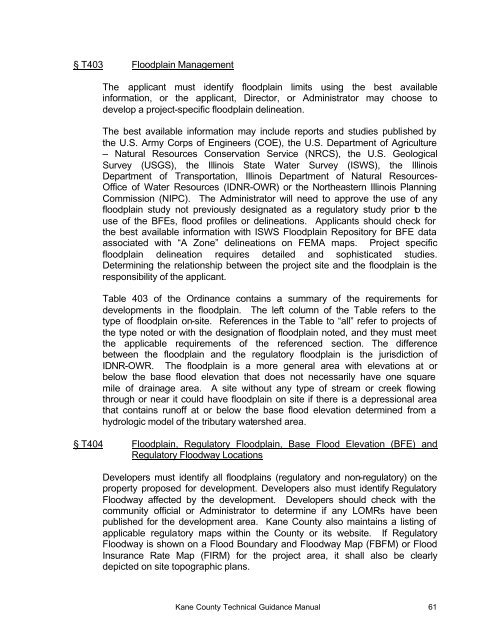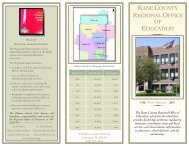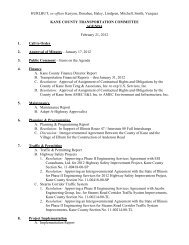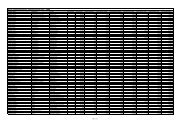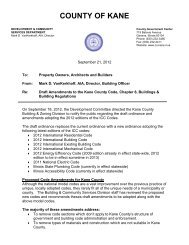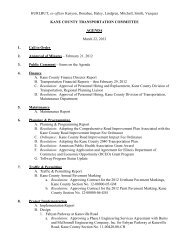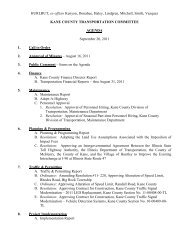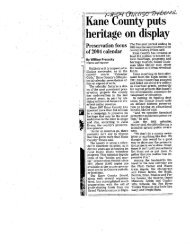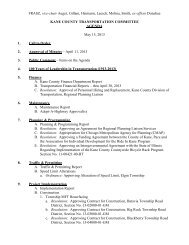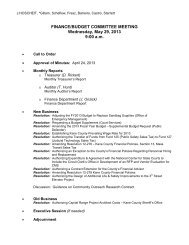kane county stormwater technical guidance manual - Kane County, IL
kane county stormwater technical guidance manual - Kane County, IL
kane county stormwater technical guidance manual - Kane County, IL
Create successful ePaper yourself
Turn your PDF publications into a flip-book with our unique Google optimized e-Paper software.
§ T403 Floodplain Management<br />
The applicant must identify floodplain limits using the best available<br />
information, or the applicant, Director, or Administrator may choose to<br />
develop a project-specific floodplain delineation.<br />
The best available information may include reports and studies published by<br />
the U.S. Army Corps of Engineers (COE), the U.S. Department of Agriculture<br />
– Natural Resources Conservation Service (NRCS), the U.S. Geological<br />
Survey (USGS), the Illinois State Water Survey (ISWS), the Illinois<br />
Department of Transportation, Illinois Department of Natural Resources-<br />
Office of Water Resources (IDNR-OWR) or the Northeastern Illinois Planning<br />
Commission (NIPC). The Administrator will need to approve the use of any<br />
floodplain study not previously designated as a regulatory study prior to the<br />
use of the BFEs, flood profiles or delineations. Applicants should check for<br />
the best available information with ISWS Floodplain Repository for BFE data<br />
associated with “A Zone” delineations on FEMA maps. Project specific<br />
floodplain delineation requires detailed and sophisticated studies.<br />
Determining the relationship between the project site and the floodplain is the<br />
responsibility of the applicant.<br />
Table 403 of the Ordinance contains a summary of the requirements for<br />
developments in the floodplain. The left column of the Table refers to the<br />
type of floodplain on-site. References in the Table to “all” refer to projects of<br />
the type noted or with the designation of floodplain noted, and they must meet<br />
the applicable requirements of the referenced section. The difference<br />
between the floodplain and the regulatory floodplain is the jurisdiction of<br />
IDNR-OWR. The floodplain is a more general area with elevations at or<br />
below the base flood elevation that does not necessarily have one square<br />
mile of drainage area. A site without any type of stream or creek flowing<br />
through or near it could have floodplain on site if there is a depressional area<br />
that contains runoff at or below the base flood elevation determined from a<br />
hydrologic model of the tributary watershed area.<br />
§ T404 Floodplain, Regulatory Floodplain, Base Flood Elevation (BFE) and<br />
Regulatory Floodway Locations<br />
Developers must identify all floodplains (regulatory and non-regulatory) on the<br />
property proposed for development. Developers also must identify Regulatory<br />
Floodway affected by the development. Developers should check with the<br />
community official or Administrator to determine if any LOMRs have been<br />
published for the development area. <strong>Kane</strong> <strong>County</strong> also maintains a listing of<br />
applicable regulatory maps within the <strong>County</strong> or its website. If Regulatory<br />
Floodway is shown on a Flood Boundary and Floodway Map (FBFM) or Flood<br />
Insurance Rate Map (FIRM) for the project area, it shall also be clearly<br />
depicted on site topographic plans.<br />
<strong>Kane</strong> <strong>County</strong> Technical Guidance Manual 61


